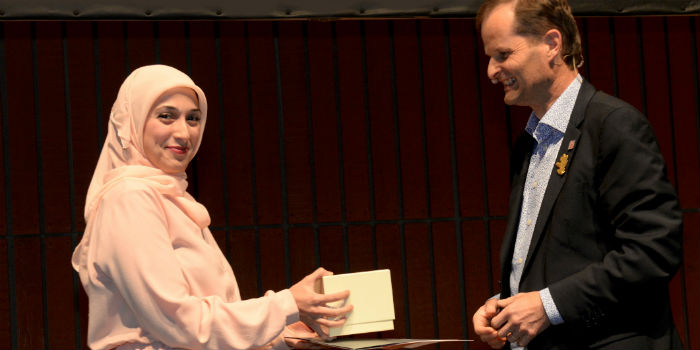Six other PhD graduates and the PhD supervisor of the year were also celebrated at the event.
On Friday, 26 October, Dean Philip Binning hosted the celebration of 178 new PhD graduates from DTU.
“To celebrate you, our new PhD graduates, we have put together an evening where we will hand out your diplomas as well as awards to the PhD thesis of the year, the PhD supervisor of the year, and the DTU Young Researcher Award,’ he said, and during the evening he firmly established that the graduates had good reason to be proud of themselves:
“Through original research, PhD graduates have contributed to the expansion of our knowledge. They have produced significant work, some of which has been nationally and internationally peer reviewed. They are expected to be able to advance within an academic context and to create technological, social, and cultural progress within a knowledge-based society,’ said Dean Philip Binning with reference to the common European definition of the content of a PhD degree.
PhD thesis of the year
Fatima AlZahra´a Alatraktchi of DTU Nanotech was awarded the PhD thesis of the year award for her thesis ‘Micro- and nano-sensors for early diagnosis of bacterial infections’. She completed her PhD project in collaboration with DTU Bioengineering, DTU Biosustain, and DTU Nanotech.
In her thesis, Fatima AlZahra´a Alatraktchi developed a revolutionary method for detecting one of the most problematic types of bacteria. The method is based on a nano-sensor and is easier, faster, and more sensitive than current methods. Compared to microbiological cultivation, which usually takes 2-3 days, the new method can produce a result in just 30 seconds.
Her work refers to seven ISI articles, of which she is first author, and has resulted in a patent and the start-up company PreDiagnose where she is CEO.

Fatima AlZ>ahra's Alatracktchi and Dean Philip Binning. Photo: Birgitte Røddik.
Dean Philip Binning called Fatima AlZahra'a Alatraktchi a rare talent who mastered two fundamentally different research areas, namely nano physics and biomedicine/molecular biology. In addition, he attributed the project's success to her interdisciplinary way of working, and to her ambitious and hard-working approach.
Finally, Fatima AlZahra'a Alatraktchi was among the nine select researchers whom Tommy Ahlers, Minister for Education and Research, invited to give their input on some of the challenges in the world of research.
PhD supervisor of the year
Each year, PhD students can nominate their supervisor for the award of PhD supervisor of the Year. This year the award went to Professor Nini Pryds from DTU Energy , where he is Head of the Section for Electrofunctional Materials.
His field of research covers magnetic cooling, thermoelectricity, and functional thin oxide film. He plays a leading role in multidisciplinary research into functional materials for energy consumption.
One of his PhD students wrote in the motivation for Nini’s nomination:
"He inspires me to direct my research towards becoming a professional researcher. He helps me find my weak points, to limit them, and improve my skills."

Professor Nini Pryds and Dean Philip Binning. Photo: Birgitte Røddik.
DTU's 'Young Researcher Award'
This award honours young researchers who have made an extraordinary effort and who have great potential for further development. This year, the award was presented to these six young researchers:
Martin Frederik Laursen, DTU Food, for his thesis: 'Development of the human gut microbiota during early life'.
Sara Lindeblad Wingstrand, DTU Chemical Engineering, for her thesis: 'On the link between nonlinear extensional rheology and morphology of polymeric fibers'.
Dennis Valbjørn Christensen, DTU Energy, for 'Exploring magnetic and electronic properties in y-Al2O3/SrTiO3'.
Emre Barlas, DTU Wind Energy, for 'Development of an advanced noise propagation model for noise optimization in wind farm'.
Nana Haahr Overgaard, DTU Bioengineering, for 'T'he pig as a large animal model for studying anti-tumor immune responses'.
Arun Kumar Somavarapu, DTU Chemistry, for 'Structural dynamics and pathogenicity of Aβ and presenilin1 variants: Towards a mechanistic understanding of Alzheimer’s disease'.